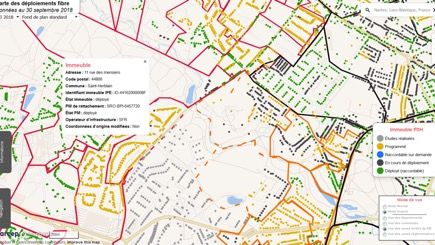SUBSCRIPTIONS: the number of end-to-end fibre optic lines increased by 50% in one year.
- Over the course of Q3 2018, the number of superfast broadband subscriptions (maximum download speed equal to or faster than 30 Mbit/s) increased by 505,000 to reach 8.4 million, or an additional 1.9 million subscriptions year on year (YoY), versus an increase of 1.4 million one year earlier. The majority of this growth is due to an increase in the number of subscriptions to fibre to the home/building (FttH/B) plans, which rose by 380,000 compared to the previous quarter and so accounting for close to 75% of the increase in superfast access user numbers. As of 30 September 2018, the number of end-to-end fibre access lines totalled 4.3 million, which is 1.4 million than the year before.
- In total, 43% of all premises eligible to subscribe to a superfast access plan were subscribing to such a plan in Q3 2018, which marks a 5% increase YoY.
- The total number of broadband and superfast broadband subscriptions stood at 28.9 million at the end of Q3 2018, which marks an increase of 245,000 over the previous quarter and of 715,000 year on year (+2.5%).
ROLLOUTS: deployments are ongoing, but they must step up the pace
Over the past four quarters, 2,988,000 additional premises have been passed for FttH, of which 752,000 in Q3 2018.
- As of 30 September 2018, 12.5 million premises were eligible to subscribe to an FttH access service, or 31% more than one year earlier.
- The pace of FttH rollouts in areas covered by public-initiative rollouts is holding steady, with an additional 207,000 additional premises passed in Q3 2018. The overall rate of line sharing remained unchanged during the quarter at 27%, and continues to be far below the rate in areas covered by public-initiative rollouts where it stands at 87%.
- In total, at the end of Q3 2018, 19.6 million households in France were able to subscribe to a superfast internet access service, all technologies combined, including 13.5 million households located outside of very high-density areas.
- FttH rollout data have been updated on the cartefibre.arcep.fr website and in the Open Data made available by Arcep.
Monitoring the legally binding FttH rollout commitments that operators have made in those parts of the country where the Government has issued a call for investment letters of intent (called "zones AMII" in French).
In early August, the Government formally accepted the commitments proposed by Orange and SFR in accordance with Article L. 33-13 of the French Postal and Electronic Communications Code (CPCE), after receiving a favourable opinion from Arcep. Pursuant to this article, Arcep is now responsible for monitoring operators’ compliance with the obligations they made.
At the end of Q3 2018, 43% of the premises in the municipalities where Orange made rollout commitments, and 29% of those where SFR has made commitments have been passed for fibre. Operators will need to step up the pace of their deployments if they are to meet their targets on time.
N.B.: the first deadline is a commitment to have at least 92% of the premises passed by the end of 2020, with the remaining being passed “on request”.
Tracking FttH rollouts: further improvements to the “cartefibre” website
Arcep continues to enhance the data made available to the public. A new feature on the cartefibre.arcep.fr website, dedicated to providing FttH rollout maps, now allows users to obtain fibre coverage information on individual buildings, and so to track the progress of FttH rollouts in a more detailed fashion. This new information will be available soon as open data.

At the same time, Arcep continues to work on developing a complete tool for monitoring national fixed network coverage for all technologies combined, at the individual address level.
